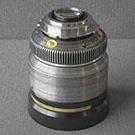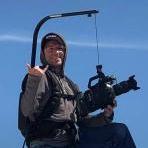
BrooklynDan
-
Posts
184 -
Joined
-
Last visited
Reputation Activity
-
 BrooklynDan got a reaction from IronFilm in Hasselblad mirrorless camera
BrooklynDan got a reaction from IronFilm in Hasselblad mirrorless camera
You got double the sensor real estate to cover compared to full frame. It's got to be an incredibly fast readout, or the image is gonna be mush. Especially with the shallow depth-of-field.
Until recently, medium format cameras used CCDs. CMOS sensors are actually a recent development in this arena. Maybe going back to those would be a smart idea. Imagine the motion cadence!
My dream would be a 645 sensor purpose-built for video with a lower pixel count. Maybe 6K or 8K spread out over a 60mm-wide sensor area. Bigger pixels = low-light monster. And then use the space between the pixels for the circuitry required for a global shutter.
-
 BrooklynDan reacted to richg101 in Hasselblad mirrorless camera
BrooklynDan reacted to richg101 in Hasselblad mirrorless camera
give me a shout when you find a lens/sensor that will replicate my leaf afi-ii 10 and a 180mm/2.8
https://c2.staticflickr.com/8/7506/26997678725_133cd94b63_o.jpg
-
 BrooklynDan got a reaction from richg101 in Hasselblad mirrorless camera
BrooklynDan got a reaction from richg101 in Hasselblad mirrorless camera
I'm not talking about math. I'm talking about SOUL. Something our industry is sorely lacking in.
-
 BrooklynDan got a reaction from IronFilm in Panavision DXL revealed, an 8K 60fps RAW cinema camera using RED's codec
BrooklynDan got a reaction from IronFilm in Panavision DXL revealed, an 8K 60fps RAW cinema camera using RED's codec
I feel like this is really gonna light a fire under Arri's belly. They've had a nonchalant attitude thus far toward their competition and have really been patient and unhurried. It's good to be the king, after all. Panavision was Arri's biggest customer, too. Has been for decades. But now that PV has united with Red, it's gonna give Red a new level of legitimacy in the high-end, and productions that might have gone Alexa on principle before will jump on this. Panavision has many, many big DPs on their side. The success of their business model is due to their skill at cultivating relationships. Those relationships are about to pay off.
-
 BrooklynDan got a reaction from AnthonyWithNoH in Is the Alexa still king? (Actual question, not an argument)
BrooklynDan got a reaction from AnthonyWithNoH in Is the Alexa still king? (Actual question, not an argument)
I work in a rental house and see Alexas, Amiras and Minis fly off the shelves all day long while F55s and Dragons sit in their boxes. And it's only increased as the attention has turned to the newer models and the original Alexa has come down in price. People who might've once settled for a prosumer-style digital cinema camera like the C300 or F3 can now afford to hire an Alexa, and many do without a moment's hesitation.
It's the only camera that really operates on a "what-you-see-is-what-you-get basis". The Canons come close, and the Reds and Sonys are a hideous mess of LOG profiles, LUTs and complicated menus. And one thing I can say for certain is that the Alexa is the only camera that is dead-on with its ISOs. ISO 800 on the Alexa is a true ISO 800, seven stops over and under middle-gray. The Canons and Sonys are somewhat faster. The FS7 in particular is way off. I would reckon that ISO 800 on that camera is closer to 1600.
Meanwhile, you can take the Alexa out of the box, hit LOG-C on 2K Prores, pull up the Rec.709 LUT on your monitor, light the scene using your light meter like they did in the good old days, and go home with an image that can look good without requiring any special color-correction sauce beyond gamma and color tweaks. And it holds up on a 40-foot screen, And it never breaks or fails. At my workplace, we practically never receive customer support calls regarding Alexas. They come back in perfect condition and our technicians turn 'em around in a matter of minutes. Meanwhile, these Reds are making my co-workers tear their hair out.
Simplicity, reliability and raw image quality independent of specs and numbers is where it's at. Arri gets this, which is why they keep winning despite the exorbitant cost of their products.
-
 BrooklynDan got a reaction from Geoff CB in Is the Alexa still king? (Actual question, not an argument)
BrooklynDan got a reaction from Geoff CB in Is the Alexa still king? (Actual question, not an argument)
I work in a rental house and see Alexas, Amiras and Minis fly off the shelves all day long while F55s and Dragons sit in their boxes. And it's only increased as the attention has turned to the newer models and the original Alexa has come down in price. People who might've once settled for a prosumer-style digital cinema camera like the C300 or F3 can now afford to hire an Alexa, and many do without a moment's hesitation.
It's the only camera that really operates on a "what-you-see-is-what-you-get basis". The Canons come close, and the Reds and Sonys are a hideous mess of LOG profiles, LUTs and complicated menus. And one thing I can say for certain is that the Alexa is the only camera that is dead-on with its ISOs. ISO 800 on the Alexa is a true ISO 800, seven stops over and under middle-gray. The Canons and Sonys are somewhat faster. The FS7 in particular is way off. I would reckon that ISO 800 on that camera is closer to 1600.
Meanwhile, you can take the Alexa out of the box, hit LOG-C on 2K Prores, pull up the Rec.709 LUT on your monitor, light the scene using your light meter like they did in the good old days, and go home with an image that can look good without requiring any special color-correction sauce beyond gamma and color tweaks. And it holds up on a 40-foot screen, And it never breaks or fails. At my workplace, we practically never receive customer support calls regarding Alexas. They come back in perfect condition and our technicians turn 'em around in a matter of minutes. Meanwhile, these Reds are making my co-workers tear their hair out.
Simplicity, reliability and raw image quality independent of specs and numbers is where it's at. Arri gets this, which is why they keep winning despite the exorbitant cost of their products.
-
 BrooklynDan got a reaction from sudopera in Is the Alexa still king? (Actual question, not an argument)
BrooklynDan got a reaction from sudopera in Is the Alexa still king? (Actual question, not an argument)
I work in a rental house and see Alexas, Amiras and Minis fly off the shelves all day long while F55s and Dragons sit in their boxes. And it's only increased as the attention has turned to the newer models and the original Alexa has come down in price. People who might've once settled for a prosumer-style digital cinema camera like the C300 or F3 can now afford to hire an Alexa, and many do without a moment's hesitation.
It's the only camera that really operates on a "what-you-see-is-what-you-get basis". The Canons come close, and the Reds and Sonys are a hideous mess of LOG profiles, LUTs and complicated menus. And one thing I can say for certain is that the Alexa is the only camera that is dead-on with its ISOs. ISO 800 on the Alexa is a true ISO 800, seven stops over and under middle-gray. The Canons and Sonys are somewhat faster. The FS7 in particular is way off. I would reckon that ISO 800 on that camera is closer to 1600.
Meanwhile, you can take the Alexa out of the box, hit LOG-C on 2K Prores, pull up the Rec.709 LUT on your monitor, light the scene using your light meter like they did in the good old days, and go home with an image that can look good without requiring any special color-correction sauce beyond gamma and color tweaks. And it holds up on a 40-foot screen, And it never breaks or fails. At my workplace, we practically never receive customer support calls regarding Alexas. They come back in perfect condition and our technicians turn 'em around in a matter of minutes. Meanwhile, these Reds are making my co-workers tear their hair out.
Simplicity, reliability and raw image quality independent of specs and numbers is where it's at. Arri gets this, which is why they keep winning despite the exorbitant cost of their products.
-
 BrooklynDan got a reaction from kaylee in Is the Alexa still king? (Actual question, not an argument)
BrooklynDan got a reaction from kaylee in Is the Alexa still king? (Actual question, not an argument)
I work in a rental house and see Alexas, Amiras and Minis fly off the shelves all day long while F55s and Dragons sit in their boxes. And it's only increased as the attention has turned to the newer models and the original Alexa has come down in price. People who might've once settled for a prosumer-style digital cinema camera like the C300 or F3 can now afford to hire an Alexa, and many do without a moment's hesitation.
It's the only camera that really operates on a "what-you-see-is-what-you-get basis". The Canons come close, and the Reds and Sonys are a hideous mess of LOG profiles, LUTs and complicated menus. And one thing I can say for certain is that the Alexa is the only camera that is dead-on with its ISOs. ISO 800 on the Alexa is a true ISO 800, seven stops over and under middle-gray. The Canons and Sonys are somewhat faster. The FS7 in particular is way off. I would reckon that ISO 800 on that camera is closer to 1600.
Meanwhile, you can take the Alexa out of the box, hit LOG-C on 2K Prores, pull up the Rec.709 LUT on your monitor, light the scene using your light meter like they did in the good old days, and go home with an image that can look good without requiring any special color-correction sauce beyond gamma and color tweaks. And it holds up on a 40-foot screen, And it never breaks or fails. At my workplace, we practically never receive customer support calls regarding Alexas. They come back in perfect condition and our technicians turn 'em around in a matter of minutes. Meanwhile, these Reds are making my co-workers tear their hair out.
Simplicity, reliability and raw image quality independent of specs and numbers is where it's at. Arri gets this, which is why they keep winning despite the exorbitant cost of their products.
-
 BrooklynDan got a reaction from dbp in Is the Alexa still king? (Actual question, not an argument)
BrooklynDan got a reaction from dbp in Is the Alexa still king? (Actual question, not an argument)
I work in a rental house and see Alexas, Amiras and Minis fly off the shelves all day long while F55s and Dragons sit in their boxes. And it's only increased as the attention has turned to the newer models and the original Alexa has come down in price. People who might've once settled for a prosumer-style digital cinema camera like the C300 or F3 can now afford to hire an Alexa, and many do without a moment's hesitation.
It's the only camera that really operates on a "what-you-see-is-what-you-get basis". The Canons come close, and the Reds and Sonys are a hideous mess of LOG profiles, LUTs and complicated menus. And one thing I can say for certain is that the Alexa is the only camera that is dead-on with its ISOs. ISO 800 on the Alexa is a true ISO 800, seven stops over and under middle-gray. The Canons and Sonys are somewhat faster. The FS7 in particular is way off. I would reckon that ISO 800 on that camera is closer to 1600.
Meanwhile, you can take the Alexa out of the box, hit LOG-C on 2K Prores, pull up the Rec.709 LUT on your monitor, light the scene using your light meter like they did in the good old days, and go home with an image that can look good without requiring any special color-correction sauce beyond gamma and color tweaks. And it holds up on a 40-foot screen, And it never breaks or fails. At my workplace, we practically never receive customer support calls regarding Alexas. They come back in perfect condition and our technicians turn 'em around in a matter of minutes. Meanwhile, these Reds are making my co-workers tear their hair out.
Simplicity, reliability and raw image quality independent of specs and numbers is where it's at. Arri gets this, which is why they keep winning despite the exorbitant cost of their products.
-
 BrooklynDan got a reaction from IronFilm in Is the Alexa still king? (Actual question, not an argument)
BrooklynDan got a reaction from IronFilm in Is the Alexa still king? (Actual question, not an argument)
I work in a rental house and see Alexas, Amiras and Minis fly off the shelves all day long while F55s and Dragons sit in their boxes. And it's only increased as the attention has turned to the newer models and the original Alexa has come down in price. People who might've once settled for a prosumer-style digital cinema camera like the C300 or F3 can now afford to hire an Alexa, and many do without a moment's hesitation.
It's the only camera that really operates on a "what-you-see-is-what-you-get basis". The Canons come close, and the Reds and Sonys are a hideous mess of LOG profiles, LUTs and complicated menus. And one thing I can say for certain is that the Alexa is the only camera that is dead-on with its ISOs. ISO 800 on the Alexa is a true ISO 800, seven stops over and under middle-gray. The Canons and Sonys are somewhat faster. The FS7 in particular is way off. I would reckon that ISO 800 on that camera is closer to 1600.
Meanwhile, you can take the Alexa out of the box, hit LOG-C on 2K Prores, pull up the Rec.709 LUT on your monitor, light the scene using your light meter like they did in the good old days, and go home with an image that can look good without requiring any special color-correction sauce beyond gamma and color tweaks. And it holds up on a 40-foot screen, And it never breaks or fails. At my workplace, we practically never receive customer support calls regarding Alexas. They come back in perfect condition and our technicians turn 'em around in a matter of minutes. Meanwhile, these Reds are making my co-workers tear their hair out.
Simplicity, reliability and raw image quality independent of specs and numbers is where it's at. Arri gets this, which is why they keep winning despite the exorbitant cost of their products.
-
 BrooklynDan got a reaction from AaronChicago in Is the Alexa still king? (Actual question, not an argument)
BrooklynDan got a reaction from AaronChicago in Is the Alexa still king? (Actual question, not an argument)
I work in a rental house and see Alexas, Amiras and Minis fly off the shelves all day long while F55s and Dragons sit in their boxes. And it's only increased as the attention has turned to the newer models and the original Alexa has come down in price. People who might've once settled for a prosumer-style digital cinema camera like the C300 or F3 can now afford to hire an Alexa, and many do without a moment's hesitation.
It's the only camera that really operates on a "what-you-see-is-what-you-get basis". The Canons come close, and the Reds and Sonys are a hideous mess of LOG profiles, LUTs and complicated menus. And one thing I can say for certain is that the Alexa is the only camera that is dead-on with its ISOs. ISO 800 on the Alexa is a true ISO 800, seven stops over and under middle-gray. The Canons and Sonys are somewhat faster. The FS7 in particular is way off. I would reckon that ISO 800 on that camera is closer to 1600.
Meanwhile, you can take the Alexa out of the box, hit LOG-C on 2K Prores, pull up the Rec.709 LUT on your monitor, light the scene using your light meter like they did in the good old days, and go home with an image that can look good without requiring any special color-correction sauce beyond gamma and color tweaks. And it holds up on a 40-foot screen, And it never breaks or fails. At my workplace, we practically never receive customer support calls regarding Alexas. They come back in perfect condition and our technicians turn 'em around in a matter of minutes. Meanwhile, these Reds are making my co-workers tear their hair out.
Simplicity, reliability and raw image quality independent of specs and numbers is where it's at. Arri gets this, which is why they keep winning despite the exorbitant cost of their products.
-
 BrooklynDan got a reaction from Liam in Is the Alexa still king? (Actual question, not an argument)
BrooklynDan got a reaction from Liam in Is the Alexa still king? (Actual question, not an argument)
I work in a rental house and see Alexas, Amiras and Minis fly off the shelves all day long while F55s and Dragons sit in their boxes. And it's only increased as the attention has turned to the newer models and the original Alexa has come down in price. People who might've once settled for a prosumer-style digital cinema camera like the C300 or F3 can now afford to hire an Alexa, and many do without a moment's hesitation.
It's the only camera that really operates on a "what-you-see-is-what-you-get basis". The Canons come close, and the Reds and Sonys are a hideous mess of LOG profiles, LUTs and complicated menus. And one thing I can say for certain is that the Alexa is the only camera that is dead-on with its ISOs. ISO 800 on the Alexa is a true ISO 800, seven stops over and under middle-gray. The Canons and Sonys are somewhat faster. The FS7 in particular is way off. I would reckon that ISO 800 on that camera is closer to 1600.
Meanwhile, you can take the Alexa out of the box, hit LOG-C on 2K Prores, pull up the Rec.709 LUT on your monitor, light the scene using your light meter like they did in the good old days, and go home with an image that can look good without requiring any special color-correction sauce beyond gamma and color tweaks. And it holds up on a 40-foot screen, And it never breaks or fails. At my workplace, we practically never receive customer support calls regarding Alexas. They come back in perfect condition and our technicians turn 'em around in a matter of minutes. Meanwhile, these Reds are making my co-workers tear their hair out.
Simplicity, reliability and raw image quality independent of specs and numbers is where it's at. Arri gets this, which is why they keep winning despite the exorbitant cost of their products.
-
 BrooklynDan got a reaction from mercer in Is the Alexa still king? (Actual question, not an argument)
BrooklynDan got a reaction from mercer in Is the Alexa still king? (Actual question, not an argument)
I work in a rental house and see Alexas, Amiras and Minis fly off the shelves all day long while F55s and Dragons sit in their boxes. And it's only increased as the attention has turned to the newer models and the original Alexa has come down in price. People who might've once settled for a prosumer-style digital cinema camera like the C300 or F3 can now afford to hire an Alexa, and many do without a moment's hesitation.
It's the only camera that really operates on a "what-you-see-is-what-you-get basis". The Canons come close, and the Reds and Sonys are a hideous mess of LOG profiles, LUTs and complicated menus. And one thing I can say for certain is that the Alexa is the only camera that is dead-on with its ISOs. ISO 800 on the Alexa is a true ISO 800, seven stops over and under middle-gray. The Canons and Sonys are somewhat faster. The FS7 in particular is way off. I would reckon that ISO 800 on that camera is closer to 1600.
Meanwhile, you can take the Alexa out of the box, hit LOG-C on 2K Prores, pull up the Rec.709 LUT on your monitor, light the scene using your light meter like they did in the good old days, and go home with an image that can look good without requiring any special color-correction sauce beyond gamma and color tweaks. And it holds up on a 40-foot screen, And it never breaks or fails. At my workplace, we practically never receive customer support calls regarding Alexas. They come back in perfect condition and our technicians turn 'em around in a matter of minutes. Meanwhile, these Reds are making my co-workers tear their hair out.
Simplicity, reliability and raw image quality independent of specs and numbers is where it's at. Arri gets this, which is why they keep winning despite the exorbitant cost of their products.
-
 BrooklynDan got a reaction from Michal Gajdoš in High demand for ARRI Alexa 65
BrooklynDan got a reaction from Michal Gajdoš in High demand for ARRI Alexa 65
They won't. The camera comes packaged with the Prime 65 lenses as well as the Codex Vault 65 data management system. The day rate is somewhere near $10k per day. And beyond some extremely high-end commercials, I can't imagine anyone using this but Hollywood features in the nine-figure budget range. The post-production costs for 6K Arriraw are astronomical.
Some day, maybe fifteen years from now, I'm sure that these Alexa 65 bodies will wind up on the used market selling for a pittance, much like the Arri D21 and Sony F35 have. But by then, I'm sure we'll have 12K IMAX-sized sensors in our DSLRs. Maybe not Canon. They'll still be doing 8-bit HD.
-
 BrooklynDan got a reaction from IronFilm in High demand for ARRI Alexa 65
BrooklynDan got a reaction from IronFilm in High demand for ARRI Alexa 65
They won't. The camera comes packaged with the Prime 65 lenses as well as the Codex Vault 65 data management system. The day rate is somewhere near $10k per day. And beyond some extremely high-end commercials, I can't imagine anyone using this but Hollywood features in the nine-figure budget range. The post-production costs for 6K Arriraw are astronomical.
Some day, maybe fifteen years from now, I'm sure that these Alexa 65 bodies will wind up on the used market selling for a pittance, much like the Arri D21 and Sony F35 have. But by then, I'm sure we'll have 12K IMAX-sized sensors in our DSLRs. Maybe not Canon. They'll still be doing 8-bit HD.
-
 BrooklynDan reacted to Brian Caldwell in SLR Magic Anamorphot CINE PL Set 35/50/70 - a shoot in London and Brighton with the Sony A7S II and Samsung NX1
BrooklynDan reacted to Brian Caldwell in SLR Magic Anamorphot CINE PL Set 35/50/70 - a shoot in London and Brighton with the Sony A7S II and Samsung NX1
The Panavision G 25mm does have severe barrel distortion. I haven't seen the new Cooke 25mm yet - does it have the same weird mix of pincushion and barrel distortion that the other Cooke anamorphics have?
-
 BrooklynDan got a reaction from Kisaha in a7r ii nothing but headaches.
BrooklynDan got a reaction from Kisaha in a7r ii nothing but headaches.
I use the Sony A7RII (as well as the Panasonic GH4) at work every week.
Fact: My personal Canon C100 eats it for breakfast when it comes to motion cadence, rolling shutter, color science and overall cinematic quality. The 4K cameras might be sharper, but only by a little, and at the end of the day, resolution is the spec that matters to me least. All the fancy tech and high-power processing in the world doesn't matter if the image isn't pleased. And I mean pleasing right out of the camera, not pleasing after several hours in DaVinci resolve wrestling with SLog. Super flat profiles work great for RAW or 10 or 12-bit RGB video. For 8-bit compressed codecs, it's generally better to have a strong REC.709 image right off the bat.
Also, the A7RII overheats after about 10 minutes of recording. Not great for interviews or long takes.
The sad thing is, once upon a time, Sony had a magical camera called the F35, which had more mojo than anything this side of the Arri Alexa. And as much as people love to chalk it up to the CCD sensor, much of that same silky cinematic quality trickled down to the CMOS-carrying Sony F3, which as other people have pointed out, continues to be a beast of a camera, especially at the low, low prices that it now sells for. But somewhere along the way, Sony switched directions and decided to go for brute-force processing power and crazy specs, rather than real cinematic image quality. And as a result, while they have gained tremendous ground at the consumer and prosumer levels, they have ceded the high-end to Arri and Red. I have a lot of friends in rental houses and they clue me in as to what is going out most often:
1. Most people hire Alexas.
2. Can't afford Arri? Go for a Red.
3. Can't afford Red, but still need 4K? Sony, it is.
4. Don't need 4K? Have a Canon C300.
-
 BrooklynDan got a reaction from Cinegain in a7r ii nothing but headaches.
BrooklynDan got a reaction from Cinegain in a7r ii nothing but headaches.
I use the Sony A7RII (as well as the Panasonic GH4) at work every week.
Fact: My personal Canon C100 eats it for breakfast when it comes to motion cadence, rolling shutter, color science and overall cinematic quality. The 4K cameras might be sharper, but only by a little, and at the end of the day, resolution is the spec that matters to me least. All the fancy tech and high-power processing in the world doesn't matter if the image isn't pleased. And I mean pleasing right out of the camera, not pleasing after several hours in DaVinci resolve wrestling with SLog. Super flat profiles work great for RAW or 10 or 12-bit RGB video. For 8-bit compressed codecs, it's generally better to have a strong REC.709 image right off the bat.
Also, the A7RII overheats after about 10 minutes of recording. Not great for interviews or long takes.
The sad thing is, once upon a time, Sony had a magical camera called the F35, which had more mojo than anything this side of the Arri Alexa. And as much as people love to chalk it up to the CCD sensor, much of that same silky cinematic quality trickled down to the CMOS-carrying Sony F3, which as other people have pointed out, continues to be a beast of a camera, especially at the low, low prices that it now sells for. But somewhere along the way, Sony switched directions and decided to go for brute-force processing power and crazy specs, rather than real cinematic image quality. And as a result, while they have gained tremendous ground at the consumer and prosumer levels, they have ceded the high-end to Arri and Red. I have a lot of friends in rental houses and they clue me in as to what is going out most often:
1. Most people hire Alexas.
2. Can't afford Arri? Go for a Red.
3. Can't afford Red, but still need 4K? Sony, it is.
4. Don't need 4K? Have a Canon C300.
-
 BrooklynDan got a reaction from Jpr in a7r ii nothing but headaches.
BrooklynDan got a reaction from Jpr in a7r ii nothing but headaches.
I use the Sony A7RII (as well as the Panasonic GH4) at work every week.
Fact: My personal Canon C100 eats it for breakfast when it comes to motion cadence, rolling shutter, color science and overall cinematic quality. The 4K cameras might be sharper, but only by a little, and at the end of the day, resolution is the spec that matters to me least. All the fancy tech and high-power processing in the world doesn't matter if the image isn't pleased. And I mean pleasing right out of the camera, not pleasing after several hours in DaVinci resolve wrestling with SLog. Super flat profiles work great for RAW or 10 or 12-bit RGB video. For 8-bit compressed codecs, it's generally better to have a strong REC.709 image right off the bat.
Also, the A7RII overheats after about 10 minutes of recording. Not great for interviews or long takes.
The sad thing is, once upon a time, Sony had a magical camera called the F35, which had more mojo than anything this side of the Arri Alexa. And as much as people love to chalk it up to the CCD sensor, much of that same silky cinematic quality trickled down to the CMOS-carrying Sony F3, which as other people have pointed out, continues to be a beast of a camera, especially at the low, low prices that it now sells for. But somewhere along the way, Sony switched directions and decided to go for brute-force processing power and crazy specs, rather than real cinematic image quality. And as a result, while they have gained tremendous ground at the consumer and prosumer levels, they have ceded the high-end to Arri and Red. I have a lot of friends in rental houses and they clue me in as to what is going out most often:
1. Most people hire Alexas.
2. Can't afford Arri? Go for a Red.
3. Can't afford Red, but still need 4K? Sony, it is.
4. Don't need 4K? Have a Canon C300.
-
 BrooklynDan got a reaction from eris in 1.79x Squeeze Anamorphic
BrooklynDan got a reaction from eris in 1.79x Squeeze Anamorphic
The red circle is caused by the old magnesium fluoride coatings on the spherical components. And considering The Thing used Panavision Super Speed lenses, the spherical components might've been from the 60s or 70s when such coatings were prevalent. The old Todd-AO 35 anamorphics as well as the Dyaliscopes had similar artifacts. If you want to reproduce it, you should pay special attention to the taking lenses you use. Maybe something like a Super Takumar, or even older glass would make it happen.
-
 BrooklynDan got a reaction from chris24g in 1.79x Squeeze Anamorphic
BrooklynDan got a reaction from chris24g in 1.79x Squeeze Anamorphic
The red circle is caused by the old magnesium fluoride coatings on the spherical components. And considering The Thing used Panavision Super Speed lenses, the spherical components might've been from the 60s or 70s when such coatings were prevalent. The old Todd-AO 35 anamorphics as well as the Dyaliscopes had similar artifacts. If you want to reproduce it, you should pay special attention to the taking lenses you use. Maybe something like a Super Takumar, or even older glass would make it happen.
-
 BrooklynDan got a reaction from austinchimp in RODNEY CHARTERS: BM POCKET CAMERA, 4K ACQUISITION & ALEXA
BrooklynDan got a reaction from austinchimp in RODNEY CHARTERS: BM POCKET CAMERA, 4K ACQUISITION & ALEXA
This is half the reason why I got a C100 instead of the 4K options in that price bracket (think GH4 or A7S II). I can make it look the way I want it in camera. I don't need labor-intensive color correction beyond basic gamma and RGB tweaks. I certainly don't need to fool around with LUTs. I grew up shooting on film. I'm comfortable working this way. And needless to say, I find HD perfectly usable for my needs.
The other half is form factor. So nice to have a proper camera with proper XLRs and an ND filter.
I actually just came home from watching The Revenant. Most of it was shot in 2.8K Arriraw on the Alexa M. Some of it was shot in 6K on the new Alexa 65. I couldn't tell which shots were which camera. And that's a massive gap in resolution. In the right hands, resolution is practically irrelevant. That said, I'd rather see what Emmanuel Lubezki could do with a VHS camcorder than what 99% of other DPs can do with a Red Dragon and Master Primes. He's a true wizard.
-
 BrooklynDan got a reaction from Xavier Plagaro Mussard in RODNEY CHARTERS: BM POCKET CAMERA, 4K ACQUISITION & ALEXA
BrooklynDan got a reaction from Xavier Plagaro Mussard in RODNEY CHARTERS: BM POCKET CAMERA, 4K ACQUISITION & ALEXA
This is half the reason why I got a C100 instead of the 4K options in that price bracket (think GH4 or A7S II). I can make it look the way I want it in camera. I don't need labor-intensive color correction beyond basic gamma and RGB tweaks. I certainly don't need to fool around with LUTs. I grew up shooting on film. I'm comfortable working this way. And needless to say, I find HD perfectly usable for my needs.
The other half is form factor. So nice to have a proper camera with proper XLRs and an ND filter.
I actually just came home from watching The Revenant. Most of it was shot in 2.8K Arriraw on the Alexa M. Some of it was shot in 6K on the new Alexa 65. I couldn't tell which shots were which camera. And that's a massive gap in resolution. In the right hands, resolution is practically irrelevant. That said, I'd rather see what Emmanuel Lubezki could do with a VHS camcorder than what 99% of other DPs can do with a Red Dragon and Master Primes. He's a true wizard.
-
 BrooklynDan got a reaction from graphicnatured in RODNEY CHARTERS: BM POCKET CAMERA, 4K ACQUISITION & ALEXA
BrooklynDan got a reaction from graphicnatured in RODNEY CHARTERS: BM POCKET CAMERA, 4K ACQUISITION & ALEXA
This is half the reason why I got a C100 instead of the 4K options in that price bracket (think GH4 or A7S II). I can make it look the way I want it in camera. I don't need labor-intensive color correction beyond basic gamma and RGB tweaks. I certainly don't need to fool around with LUTs. I grew up shooting on film. I'm comfortable working this way. And needless to say, I find HD perfectly usable for my needs.
The other half is form factor. So nice to have a proper camera with proper XLRs and an ND filter.
I actually just came home from watching The Revenant. Most of it was shot in 2.8K Arriraw on the Alexa M. Some of it was shot in 6K on the new Alexa 65. I couldn't tell which shots were which camera. And that's a massive gap in resolution. In the right hands, resolution is practically irrelevant. That said, I'd rather see what Emmanuel Lubezki could do with a VHS camcorder than what 99% of other DPs can do with a Red Dragon and Master Primes. He's a true wizard.
-
 BrooklynDan got a reaction from artiswar in Anamorphic and Zooms
BrooklynDan got a reaction from artiswar in Anamorphic and Zooms
I think that was a pretty successful experiment. You zoomed in and out while maintaining focus and preserved that great anamorphic feel. Don't forget, the few front anamorphic zooms out there from Hawk and Panavision are rare and incredibly expensive. This set-up must've cost what a Hawk 45-90mm costs for a single rental day.












